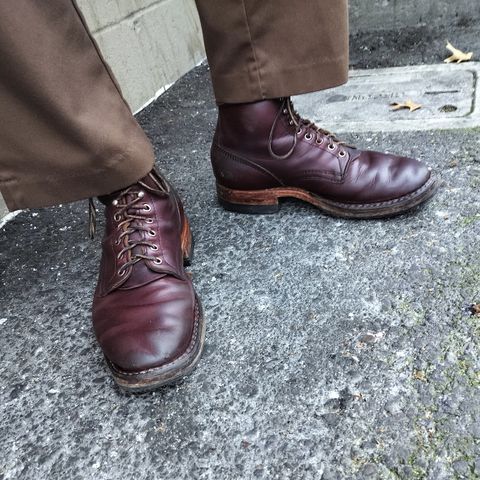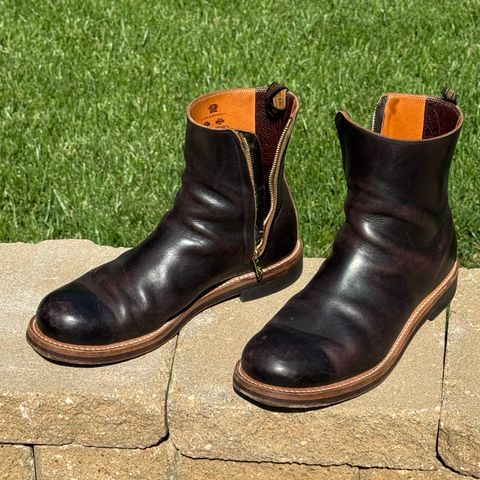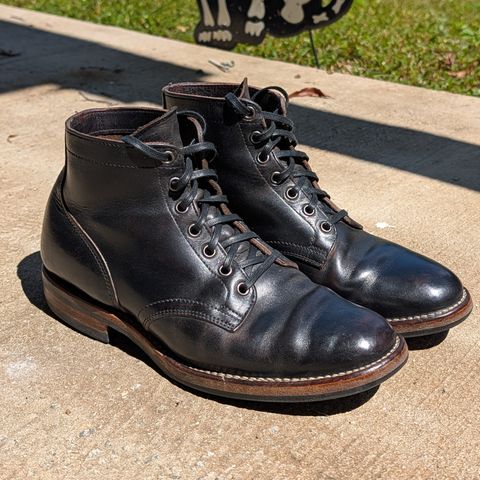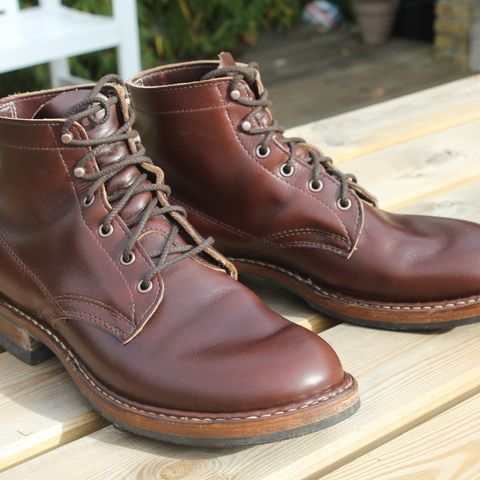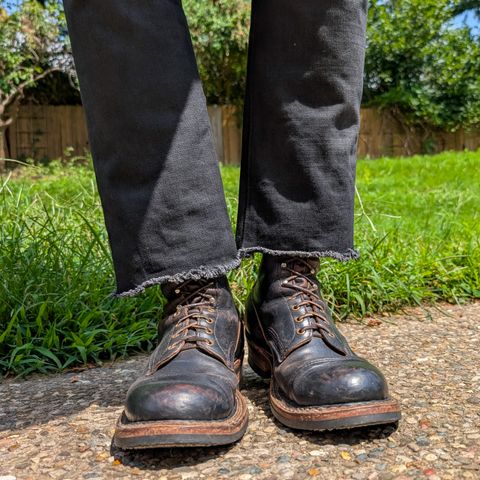About
Chromexcel is a combination-tanned leather produced by Horween Leather Company in Chicago, Illinois. Developed in 1911, it is characterized by its distinctive "pull-up" effect, where oils and waxes temporarily displace when the leather is stretched or bent, creating color variations that showcase the leather's natural grain. The leather undergoes an extensive 89-step manufacturing process taking 28 working days, utilizing all five floors of Horween's facility.
About
Chromexcel is a combination-tanned leather produced by Horween Leather Company in Chicago, Illinois. Developed in 1911, it is characterized by its distinctive "pull-up" effect, where oils and waxes temporarily displace when the leather is stretched or bent, creating color variations that showcase the leather's natural grain. The leather undergoes an extensive 89-step manufacturing process taking 28 working days, utilizing all five floors of Horween's facility.
Chromexcel is recognized as the original pull-up leather, produced using time-honored techniques and proprietary formulas that have remained largely unchanged for over a century. Its combination tanning process—chrome tanning followed by vegetable retanning with bark extracts—creates a leather that is both soft and durable, making it well-suited for heritage-style footwear and high-grade leather goods.
The leather is valued by boot makers and craftspeople for its aging characteristics, developing a rich patina over time while maintaining structural integrity. Its low maintenance requirements and characteristic appearance have made it a standard choice for American heritage footwear brands and a reference point among leather enthusiasts and collectors.
Manufacturing Process
Chromexcel production represents one of the most complex leather manufacturing processes in modern tanning, requiring precise control of chemistry including specific concentrations, temperatures, run times, and pH levels. The process begins with raw hide inspection and quality assessment, followed by hair removal using lime solutions in industrial cement mixers.
The initial tanning stage utilizes chrome tanning in large wooden drums capable of holding approximately 20,000 pounds of material. After 48 hours in the chrome solution, the hides achieve the characteristic blue color of chrome-tanned leather, known in the industry as "wet blue." This chrome tanning stage yields the soft, supple, and durable foundation that distinguishes combination-tanned leathers.
The defining characteristic of Chromexcel comes from its vegetable retanning process, utilizing Horween's proprietary blend of bark extracts. The company has been producing its own vegetable tanning liqueur since 1905, using vegetable tanning pits approximately eight feet deep where skins are immersed with the combination of tree extracts. This vegetable retanning enhances the benefits of chrome tanning while adding the roundness, fullness, and enhanced aging characteristics associated with vegetable-tanned leather.
The hot stuffing process represents the final critical stage, where hides are impregnated with oils, waxes, and greases that remain solid at room temperature. Horween creates proprietary blends using food-grade beef tallow and cosmetic-grade beeswax, applied through steamed mills. This process is directly responsible for Chromexcel's signature pull-up characteristic and water resistance properties.
Final finishing involves multiple hand-rubbed coats of aniline (non-pigmented) finish and Neatsfoot oil application, ensuring the leather maintains its natural grain patterns while achieving the rich, deep coloration that develops further with use and aging.
Properties and Characteristics
The pull-up effect that defines Chromexcel results from the hot stuffing process, where oils and waxes infused into the leather fibers create temporary color displacement when the material is stretched, bent, or flexed. This phenomenon causes lighter areas to appear where the leather is stressed, immediately returning to the original shade when pressure is released, providing visual evidence of the leather's flexibility and oil content.
Chromexcel exhibits notable aging characteristics, developing what leather enthusiasts describe as a vintage appearance without the associated fragility. The leather lightens and darkens naturally through use, developing scuffs and patina that enhance rather than detract from its appearance. This aging process occurs gradually and predictably, making it well-suited for items intended for long-term use.
The combination tanning process creates a material that captures the advantages of both chrome and vegetable tanning methods. From chrome tanning comes notable softness, suppleness, and durability, while vegetable retanning contributes structural integrity, shape retention, and the ability to develop rich patina over time. This synthesis results in leather that is both immediately comfortable and long-lasting.
Maintenance requirements for Chromexcel remain minimal due to its inherent oil and wax content. The leather resists drying and cracking under normal use conditions, requiring only occasional cleaning and conditioning to maintain its appearance and performance characteristics. This low-maintenance profile contributes to its popularity among consumers seeking high-quality leather goods without extensive care requirements.
Applications
Chromexcel has become synonymous with American heritage-style footwear, finding particular favor in the production of service boots, boat shoes, and moccasins. Its combination of durability, comfort, and characteristic appearance makes it a common choice for manufacturers seeking to create footwear with authentic American workwear heritage. The leather's natural break-in properties and comfort characteristics have established it as a standard in the high-end boot market.
Watch strap applications represent another significant market for Chromexcel, where its aging properties and comfort against skin make it well-suited. The leather's ability to conform to the wearer while maintaining its structure over time creates watch straps that improve with use, developing unique patina patterns that reflect individual wearing habits.
High-end leather goods manufacturing utilizes Chromexcel for wallets, belts, bags, and accessories where both durability and aesthetic appeal are priorities. The leather's natural grain patterns and depth of color make it ideal for products requiring visual impact, while its structural properties ensure longevity in demanding applications such as belt construction and bag manufacturing.
Luxury furniture upholstery occasionally features Chromexcel, though its use in this application is limited by cost considerations and the specialized nature of the material. When employed in furniture applications, it provides notable comfort and develops attractive patina patterns that enhance the piece's character over time.
History and Development
The development of Chromexcel traces to 1911 when Isadore Horween developed and produced Aniline Chromexcel, establishing one of Horween Leather Company's most traditional tannages. This innovation represented a significant advancement in leather manufacturing, combining the durability advantages of chrome tanning with the aesthetic and aging benefits of vegetable tanning processes.
Horween Leather Company, founded in 1905 by Isadore Horween, a Ukrainian immigrant who had learned the leather trade in his homeland, established the company initially focusing on razor strap production. When safety razors emerged in 1912, reducing demand for razor strops, the company's earlier development of Chromexcel positioned it well for the transition to other leather applications.
The company's move to its current location at 2015 North Elston Avenue in Chicago's Bucktown neighborhood in 1920 provided the five-story facility that continues to house Chromexcel production today. This location, chosen for its proximity to Chicago's meat-packing industry and transportation infrastructure, has remained the sole production site for authentic Chromexcel leather for over a century.
Horween's commitment to traditional manufacturing methods has preserved the original Chromexcel formulas and techniques despite numerous opportunities for modernization and cost reduction. The company's philosophy of maintaining quality over efficiency has ensured that contemporary Chromexcel production follows the same fundamental processes developed over a century ago, including the proprietary bark extract formulations and hot stuffing techniques that define the leather's unique characteristics.
Varieties and Specifications
Chromexcel production encompasses a full range of weights and configurations to serve diverse manufacturing applications. Standard offerings include weights from 2-3 oz (0.8-1.2 mm) horsefronts for lightweight applications to 9-10 oz (3.6-4.0 mm) cowhide suitable for heavy-duty construction. Common commercial weights include 3.5/4oz, 4.5/5oz, 6/7oz, and 8/10oz specifications, each offering different characteristics suited to specific applications.
Multiple varieties within the Chromexcel family address specialized requirements, including Wooly, Beaufort, Cavalier, Plainsman, Huntsman, Kudu, and Horsefront variations. These versions utilize different base materials, finishing techniques, or specialized treatments while maintaining the fundamental combination tanning and hot stuffing processes that define Chromexcel characteristics.
The leather is available in numerous distinctive colors including Natural, Brown, Black, Autumn, and Color #8, each offering unique aging characteristics. For detailed information about specific color properties, aging patterns, and applications, see the dedicated articles for individual color variations.
The semi-soft firmness rating characteristic of Chromexcel makes it suitable for applications requiring both structural integrity and flexibility, contributing to its versatility across footwear, accessories, and specialty applications where high-quality leather characteristics are essential.
References
"Chromexcel® — Horween Leather Co.". Horween Leather Company. March 23, 2010. Retrieved September 5, 2025.
"The Tanning Process for Horween Chromexcel – DaLuca Straps". DaLuca Straps. Retrieved September 5, 2025.
"What is Chromexcel Leather? - The Journal". Cheaney. Retrieved September 5, 2025.
"Horween Chromexcel Leather: A Rich Legacy of Craftsmanship and Quality". Leather Jacket Master. Retrieved September 5, 2025.
"What Are Chromexcel Boots?". Nick's Boots. Retrieved September 5, 2025.
"Horween Chromexcel Leather Panel, Natural - Buckleguy.com". Buckleguy. Retrieved September 5, 2025.
"Horween Leather Company". Encyclopedia.com. Retrieved September 5, 2025.
